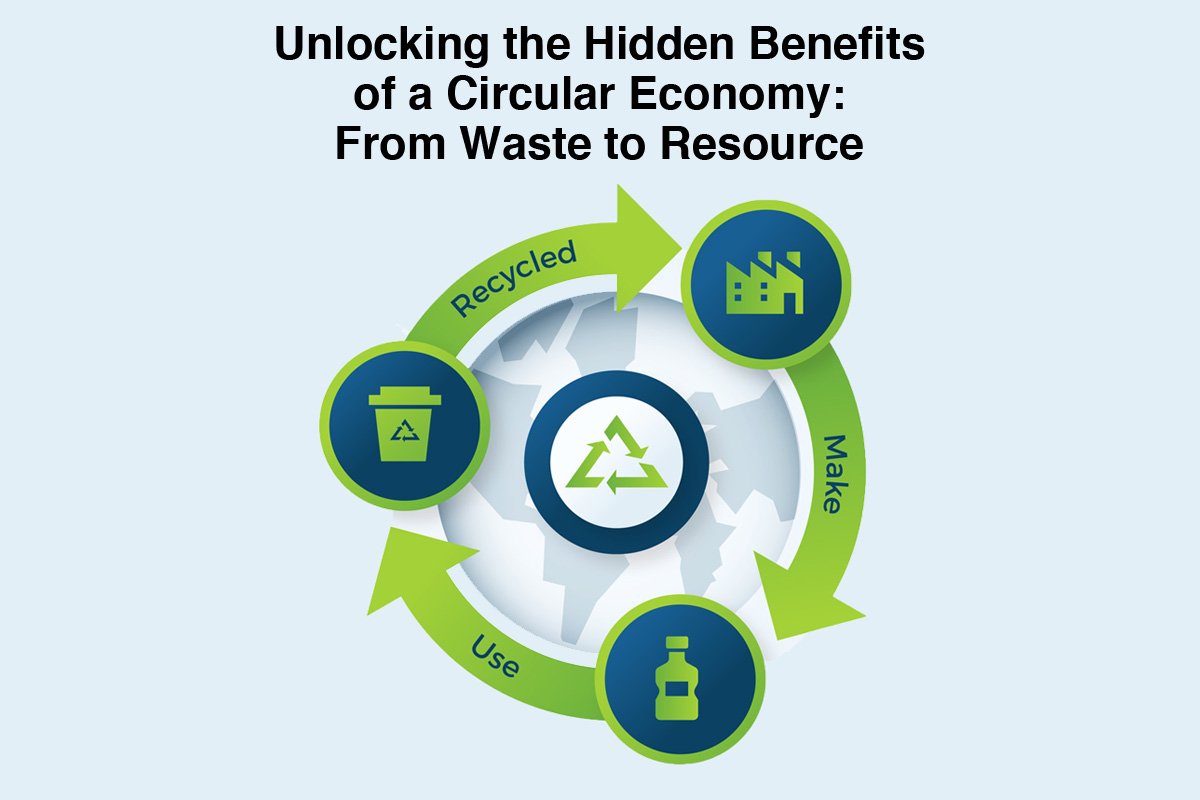With the increase in the global population, the demand for resources and the amount of waste produced also rise. Our current economic model is linear, following the “take-make-dispose” approach, where resources are extracted, transformed into products, and then discarded once they are no longer useful. This has been successful in driving economic growth, but it has also caused environmental damage and depletion of resources. The circular economy model presents an alternative approach and benefits that could lead us towards a more sustainable future.
What is the Circular Economy?
It is an economic model aimed at being restorative and regenerative by design. Its objective is to keep resources in use for as long as possible by closing the waste and recycling loop. This implies that products, components, and materials are reused, repaired, or recycled instead of being thrown away. The ultimate goal is to establish a closed-loop system where waste becomes a resource, and the materials used in products are kept in circulation.
This model is based on three fundamental principles:
1. Plan for circularity: The objective is to create products that can be reused, repaired, or recycled. This involves selecting materials that can be easily disassembled and repurposed or recycled.
2. Sustain materials in use: The goal is to extend the lifespan of products by reusing, repairing, or recycling their materials. This maximizes the use of resources.
3. Revitalize natural systems: This model strives to revitalize natural systems by utilizing renewable resources, decreasing waste, and reducing pollution.
Benefits of Embracing a Circular Economy Approach
1. Enhanced Resource Management
The circular economy approach advocates for efficient resource management by prolonging the use of resources. This implies that the production of the same quantity of goods requires fewer resources. Based on a study by the Ellen MacArthur Foundation, this approach could generate savings of up to $4.5 trillion globally by 2030 through optimized resource utilization.
2. Boosted Economic Development
The adoption of a circular economy model has the potential to spur economic growth. The circular economy model is anchored on the concept of converting waste into a resource, which could create novel job opportunities and business openings in the fields of waste management and recycling. According to a report by the European Commission, the circular economy model could generate 700,000 fresh employment opportunities in Europe by 2030.
3. Environmental Advantages
The circular economy approach could yield significant environmental advantages as well. By prolonging the use of resources as much as possible, we can decrease the amount of waste we generate and minimize our impact on natural systems. According to a report published by the Ellen MacArthur Foundation, adopting the circular economy approach could reduce worldwide greenhouse gas emissions by 45% by 2050.
4. Reduced Reliance on Raw Materials
The circular economy approach aims to keep resources in use for as long as possible, which could decrease our reliance on raw materials. By reusing, repairing, and recycling materials, we can decrease the number of new materials we need to extract from the earth. This could aid in the preservation of natural resources and decrease our impact on the environment.
5. Enhanced Productivity and Innovation
Adopting this approach could also lead to enhanced productivity and innovation. This model necessitates a shift in the way products are designed, manufactured, and disposed of, which could motivate businesses to innovate and create new technologies and business models. This could result in more efficient production processes and new products and services that are better suited to a circular economy.
Instances of Circular Economy Practices
1. Reuse
Reuse is a fundamental aspect of the circular economy approach. By reusing items, we can extend the lifespan of resources and decrease the amount of waste generated. Reusing also aids in the preservation of natural resources and minimizes our impact on the environment.
2. Design for Sustainability
Design for sustainability is a critical element of the circular economy approach. Products are created with the intention of being reused, repaired, or recycled, implying that the materials employed in their production are meticulously selected to ensure that they can be dismantled and reused or recycled with ease. This design philosophy necessitates a shift in thinking from the traditional linear economy model, in which products are designed for obsolescence, and consumers are urged to replace them frequently.
3. Collaborative Economy
The collaborative economy is another instance of a circular economy practice. By collaborating on resources, such as vehicles or lodging, we can diminish the number of resources required to offer the same level of service. This collaborative model can also help to decrease waste by extending the lifespan of products and resources.
4. No Waste
No waste is another example of a circular economy practice. The no-waste approach aims to eradicate waste by reimagining products and production processes. This approach necessitates that businesses take accountability for the complete lifecycle of their products, from creation to disposal.
5. Product as a Utility
Product as a utility is a business model that provides consumers with usage of products rather than possession. This model can help to decrease waste by urging businesses to design products that are long-lasting and can be utilized by numerous consumers. This approach also motivates businesses to design products that can be easily repaired and maintained, which can extend the life of the product.
Obstacles to Embracing a Circular Economy Approach
Although there are numerous potential benefits to embracing a circular economy approach, there are also a variety of challenges that must be overcome to make it a reality. One of the most significant obstacles is the requirement for systemic transformation. The circular economy necessitates a shift in thinking and actions from both enterprises and consumers, which can be difficult to achieve.
Another hurdle is the requirement for new infrastructure to support the circular economy. This includes infrastructure for recycling and waste management, as well as infrastructure for resource sharing and the implementation of new business models.
Finally, there is a need for policies and regulations to assist in the transition to a circular economy. This includes policies that promote resource efficiency and waste reduction, as well as regulations that encourage businesses to adopt this model.
Conclusion
It provides an alternative economic model that has the potential to help us move towards a more sustainable future. By keeping resources in use for as long as possible, the circular economy promotes resource efficiency, economic growth, and environmental benefits. However, adopting the circular economy model necessitates a change in thinking and actions from both enterprises and consumers, as well as new infrastructure and policy support. Despite the obstacles, the benefits of a circular economy are too significant to ignore, and it is up to all of us to work towards a more sustainable future.



